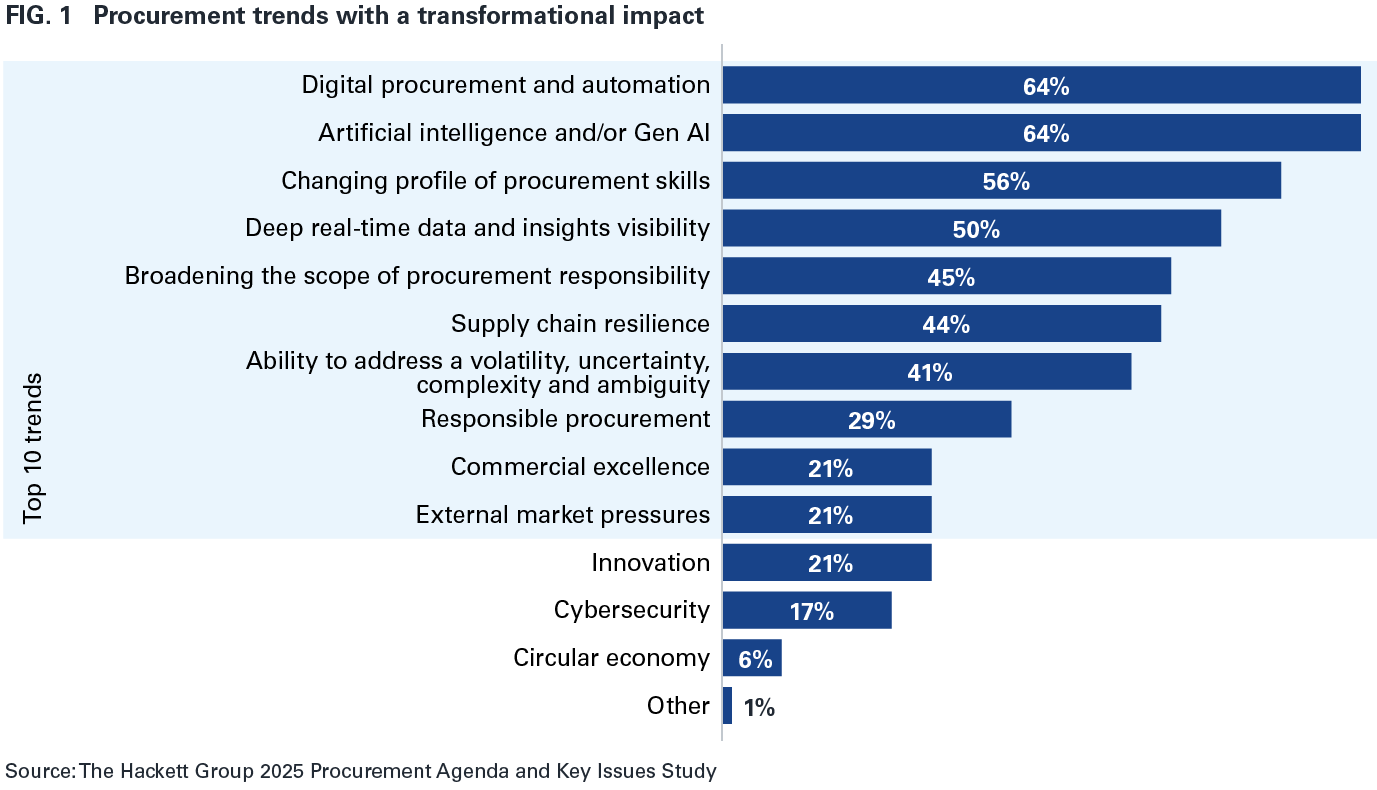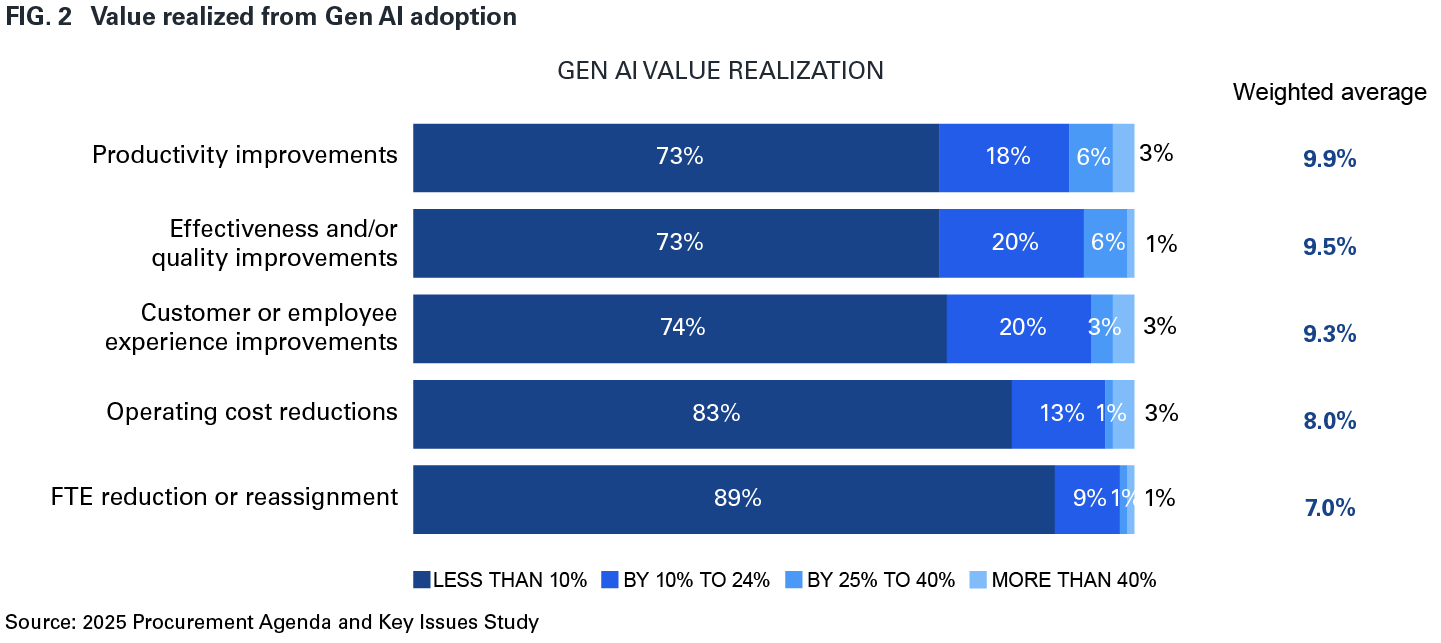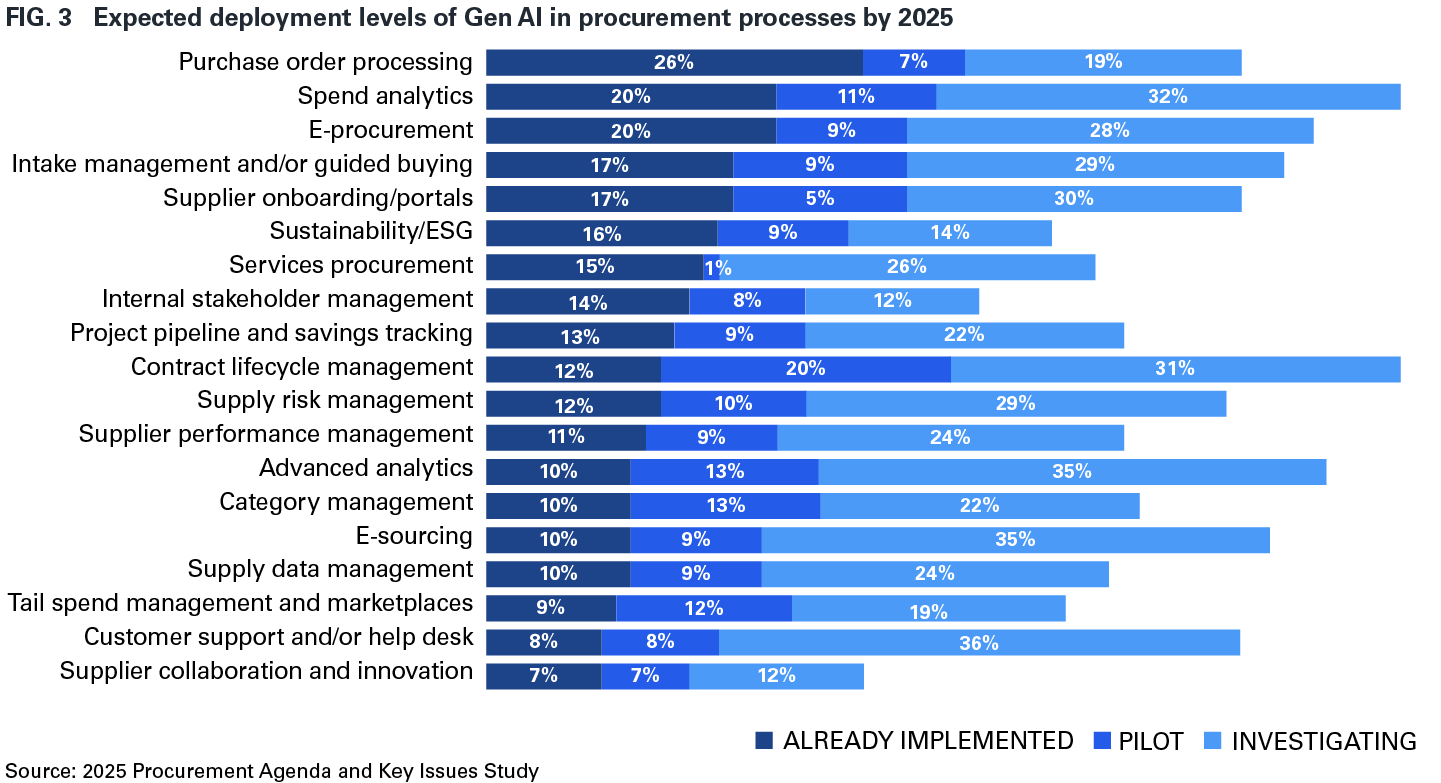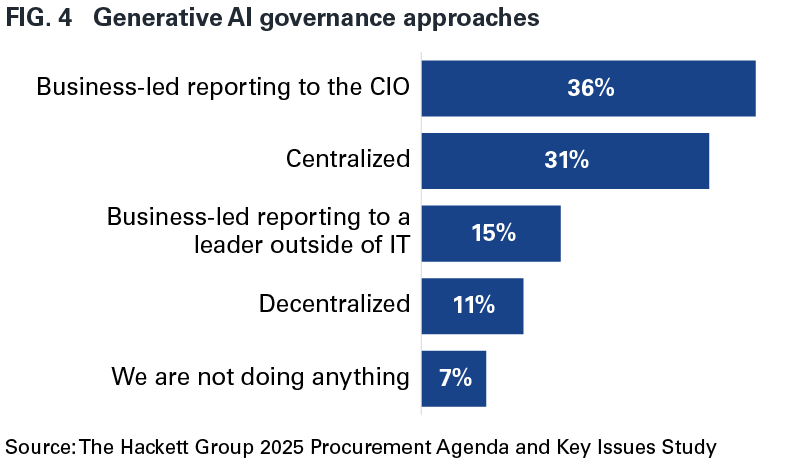Embracing the Future: How Generative AI Is Revolutionizing Procurement in 2025
In the short span of just a single year generative artificial intelligence (Gen AI) has transitioned from the early stages of exploration to a key driver of business acceleration for procurement organizations. According to The Hackett Group’s Enterprise Key Issues Study, 89% of executives across business functions said their organizations are advancing Gen AI initiatives, up from 16% in the prior year. And procurement leaders are recognizing the imperative in front of them.
Nearly two-thirds (64%) of procurement executives anticipate that Gen AI will fundamentally change how their teams operate within the next five years – in fact, Gen AI was selected by procurement leaders as the top trend for transformational impact, along with digital procurement and automation (Fig. 1). AI and Gen AI are expected to enhance system functionalities and unlock a broader value proposition for procurement teams.

Procurement leaders are keen to embrace Gen AI and the fundamental transformation it promises, but to do that they must embrace another fundamental challenge: they must rethink and reimagine their work and their workforce to determine specifically where Gen AI can assist and augment human work, and where AI agents can work autonomously.
Defining Al
Assistants: Intelligent applications that understand natural language and use conversational interfaces to complete tasks on behalf of users.
Agents: Intelligent applications that perform tasks autonomously on behalf of users or other systems without the need for constant human intervention.
Together these tools are poised to revolutionize operations by enhancing efficiency, reducing manual errors and providing real-time insights that enable more agile decision-making.
Gen AI’s promising role in procurement
In 2024 there was a great Gen AI awakening within procurement teams as these organizations began to truly understand the technology’s potential within their function – 49% of procurement teams piloted Gen AI in 2024, more than double the 23% of procurement teams that reported piloting Gen AI the year before.
Gen AI deployment is still in its early days, so the true value realization potential remains to be determined, but procurement teams have already observed tangible benefits, with improvements reaching up to 10% across productivity, effectiveness and user experience. In some cases, improvements have exceeded 25%, hinting at Gen AI’s transformative potential (Fig. 2).

Use cases and early implementations
The areas where Gen AI is making the most immediate impact in procurement include purchase order processing, spend analytics and e-procurement. Pilot programs are also exploring advanced applications in contract lifecycle management, category management and customer support. About 47% of organizations use embedded Gen AI features in existing solutions, such as Coupa AI Classification and SAP’s Joule Copilot, while 30% rely on custom-built or general purpose tools like Microsoft Copilot. It is likely that Gen AI uptake will accelerate as greater numbers of embedded solutions become available in the marketplace.
Only a small number of organizations (7%) are currently developing Gen AI capabilities within procurement centers of excellence (COEs), but this area is poised for significant growth, as 28% of procurement organizations are piloting COE initiatives, and another 41% are actively planning or evaluating them. These developments suggest a strategic pivot to centralized and scalable Gen AI capabilities in the near future (Fig. 3).

Overcoming challenges in Gen AI adoption
As organizations have begun to delve deeper into Gen AI, they’ve encountered several challenges. Data quality, privacy concerns and the convolutions of existing technology and process landscapes rank high on the list. Moreover, unrealistic benefit expectations and intellectual property risks add layers of complexity. Notably, 53% of procurement leaders report moderate to major concerns about overestimating potential benefits.
To address these hurdles, organizations are ramping up investment in technology and talent. Procurement budgets for technology are expected to grow by 5.6% in 2025, reflecting a clear focus on Gen AI. Furthermore, reskilling and upskilling initiatives are becoming a priority as teams prepare to work alongside intelligent agents and assistants.
Governance
Establishing proper governance is critical in the early days of Gen AI transformation. As Gen AI can help a company reimagine work, guidelines around its deployment and management are paramount. The Hackett Group’s 2025 Procurement Key Issues Study identified the four most used methodologies (Fig. 4). The first is a business-led approach, where delivery teams report to the CIO (36%). This is followed by a centralized deployment model (31%), in which strategy, prioritization, execution and governance are managed by a dedicated central team. The third is a business-led methodology with teams reporting to a leader outside of IT (15%). The final is a decentralized approach (11%) with AI teams directly embedded within business units or functional teams to define and implement AI strategies. The strongest preference is for center-led or centralized approaches to Gen AI deployment.

The competitive edge of Gen AI
Early adopters of Gen AI are already reaping substantial rewards. These pioneers are reimagining workflows, improving efficiency and enhancing both employee and customer experiences. For example, procurement teams have cited a weighted average productivity improvement of 9.9% and effectiveness and quality improvement of 9.5%. These advancements are significant and could be the pivotal advantage for gaining a competitive edge in today’s dynamic market.
The focus on practical use cases, such as automating repetitive tasks and integrating advanced analytics, has been instrumental. But the most interesting and impactful use cases are surely still to come – key use cases that will leverage Gen AI to enable procurement to do more than ever before.
But procurement leaders recognize that to stay ahead, they must move beyond pilots and scale their initiatives effectively. Organizations that lag risk being left behind as other organizations leverage Gen AI for unparalleled value delivery. In addition, as they scale Gen AI enterprise-wide, they must reimagine how they will work while also remaining mindful of such concerns as process complexity, data quality, technological complexity, change management and setting realistic expectations.
Strategic priorities for 2025
The Hackett Group’s 2025 Procurement Agenda and Key Issues Study has highlighted the top priorities for procurement leaders for the current year.
The top five 2025 procurement priorities are:
- Improving spend reduction: Reducing the cost of supplier spend remains a core priority. Spend cost reduction features as the primary objective for procurement organizations for the second year in a row, likely due to an uncertain economic outlook.
- Ensuring supply continuity: Supply continuity holds the number-two position for the second year in a row. Supply issues remain top of mind for many teams due to ongoing geopolitical disruption and expected shifts in trade relations following the US government transition in 2025. Supply continuity is critical to protect revenue and profitability.
- Transforming the operating model: Transforming the operating model (e.g., process, technology, people) has moved up from fifth place in 2024. As teams consider factors such as the need to simplify, heightened business expectations and potential Gen AI impacts, the operating model should adapt to meet evolving requirements.
- Combating inflationary pressures: Although rates of inflation have stabilized (and, in some cases, eased), the economic outlook remains uncertain. Combating inflationary price increases remains a key priority. Teams need to use the capabilities developed in this area to manage price inflation closely with suppliers in 2025.
- Digital transformation: Digital transformation continues to be an essential enabler for procurement organizations in their ongoing quest to do more with less through better intelligence – with increased speed, greater customer-centricity and better competitive advantage.
Gen AI projects feature prominently in the top 10 planned initiatives for 2025. However, these initiatives currently rank low in maturity. Addressing this gap will require focused efforts in execution, training and change management.
Actions for procurement leaders
To maximize Gen AI’s potential, procurement leaders should take the following steps:
- Prioritize workforce reskilling: Preparing teams to collaborate effectively with Gen AI technologies is critical for future success.
- Invest in automation and advanced analytics: Automating routine tasks and harnessing real-time data insights will unlock significant value.
- Enhance user-centric designs: Ensuring intuitive interfaces and seamless user experiences will drive adoption and satisfaction.
Looking ahead
Gen AI is no longer a speculative concept about a far-off future – it is a transformative force reshaping procurement organizations today, one that is calling on them to reimagine their work and their workforce. This challenge is not without risk – including potential data privacy and regulatory concerns – but all of the risks are manageable with the right strategies in place. The greater danger lies in inertia. Organizations that fail to integrate Gen AI into their operations risk losing their competitive edge.
Procurement leaders need to determine when and how AI should be best deployed to assist and augment workers, and also where it can work best autonomously. By adopting a structured approach to ideation, use case development and implementation, procurement teams can unlock unprecedented opportunities and drive sustainable value.
It’s time to act. Contact us for more information or to schedule a demonstration.




